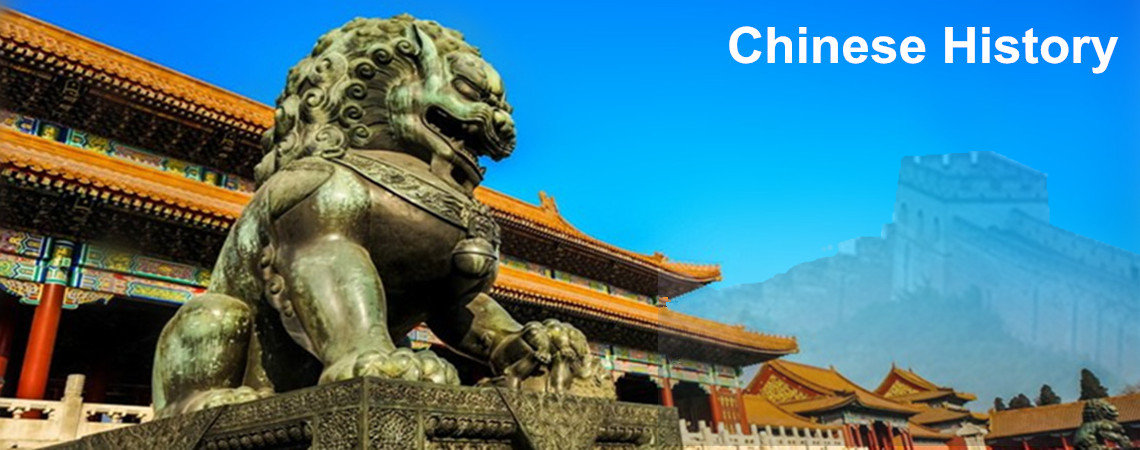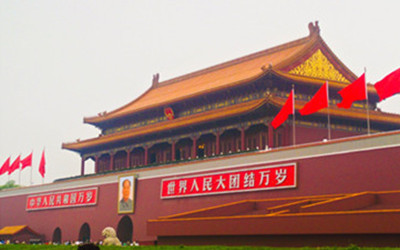
P R China (1949-)
 The People's Republic of China (PRC) is the present form of government in mainland China. The People's Republic was founded in 1949 by the Communist Party of China. After 28 years of civil war and war against the Japanese occupation the Communist Party and its People's Liberation Army were able to force the National Army under the party Kuo-min-tang (KMT) into submission or to flee to the island of Taiwan. The history of the People's Republic can be divided into the Maoist era, and the era of Reform and Opening.
The People's Republic of China (PRC) is the present form of government in mainland China. The People's Republic was founded in 1949 by the Communist Party of China. After 28 years of civil war and war against the Japanese occupation the Communist Party and its People's Liberation Army were able to force the National Army under the party Kuo-min-tang (KMT) into submission or to flee to the island of Taiwan. The history of the People's Republic can be divided into the Maoist era, and the era of Reform and Opening.Chairman Mao Zedong (Ruled 1949-1976)
On 1 October 1949, Chairman Mao Zedong proclaimed the establishment of the People's Republic of China.
In 1950, the People's Liberation Army succeeded in capturing Hainan from the ROC and incorporating Tibet. However, remaining Kuomintang forces continued to wage an insurgency in western China throughout the 1950s.The regime consolidated its popularity among the peasants through land reform.Under its leadership, China developed an independent industrial system and its own nuclear weapons.
In 1966, Mao and his allies launched the Cultural Revolution, sparking a decade of political recrimination and social upheaval which lasted until Mao's death in 1976.
In October 1971, the PRC replaced the Republic of China in the United Nations, and took its seat as a permanent member of the Security Council.
In 1950, the People's Liberation Army succeeded in capturing Hainan from the ROC and incorporating Tibet. However, remaining Kuomintang forces continued to wage an insurgency in western China throughout the 1950s.The regime consolidated its popularity among the peasants through land reform.Under its leadership, China developed an independent industrial system and its own nuclear weapons.
In 1966, Mao and his allies launched the Cultural Revolution, sparking a decade of political recrimination and social upheaval which lasted until Mao's death in 1976.
In October 1971, the PRC replaced the Republic of China in the United Nations, and took its seat as a permanent member of the Security Council.
The era of Reform and Opening
Chairman Hua Guofeng ( Ruled 1976-1981)
In 1976, Hua Guofeng became the Chairman of the CCP after Mao's death,and the Gang of Four was quickly
arrested and held responsible for the excesses of the Cultural Revolution.
In 1978, Deng Xiaoping took power and instituted significant economic reforms. This marked China's transition from a planned economy to a mixed economy with an increasingly open-market environment.China adopted its current constitution on 4 December 1982.
In 1989, the violent suppression of student protests in Tiananmen Square brought condemnation and sanctions against the Chinese government from various countries.
President Jiang Zemin (Ruled 1989-2002)
Jiang Zemin, Li Peng and Zhu Rongji led the nation in the 1990s. Under their administration, China's economic performance pulled an estimated 150 million peasants out of poverty and sustained an average annual gross domestic product growth rate of 11.2%.The country formally joined the World Trade Organization in 2001.
President Jiang Zemin (Ruled 2003-2012)
Maintained its high rate of economic growth under Hu Jintao and Wen Jiabao's leadership in the 2000s. However, rapid growth also severely impacted the country's resources and environment,and caused major social displacement.Living standards continued to improve rapidly despite the late-2000s recession, but centralized political control remained tight. Preparations for a decadal Communist Party leadership change in 2012 were marked by factional disputes and political scandals.
President Xi Jinping (Ruled 2012- )
During China's 18th National Communist Party Congress in November 2012, Hu Jintao was replaced as General Secretary of the Communist Party by Xi Jinping.Under Xi, the Chinese government began large-scale efforts to reform its economy,which has suffered from structural instabilities and slowing growth.The Xi–Li Administration also announced major reforms to the one-child policy and prison system.
President Xi Jinping (Ruled 2012- )
During China's 18th National Communist Party Congress in November 2012, Hu Jintao was replaced as General Secretary of the Communist Party by Xi Jinping.Under Xi, the Chinese government began large-scale efforts to reform its economy,which has suffered from structural instabilities and slowing growth.The Xi–Li Administration also announced major reforms to the one-child policy and prison system.







 Ask Questions ?
Ask Questions ?